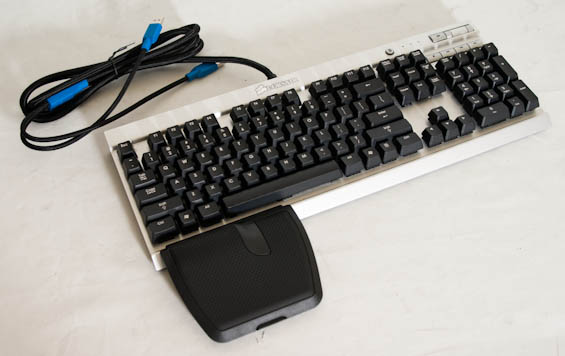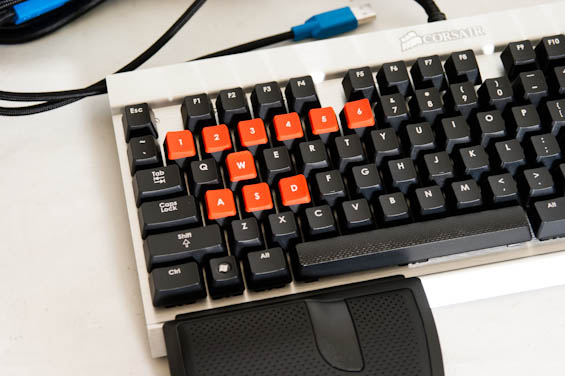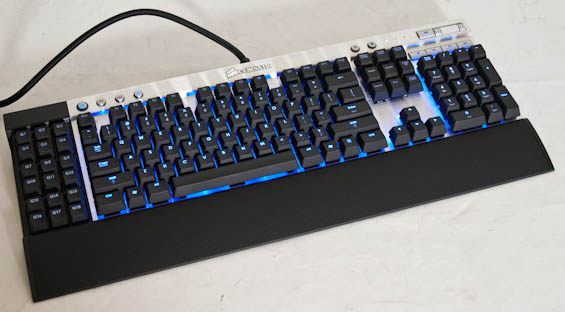Capsule Review: Corsair's Vengeance K60 and K90 Keyboards
by Dustin Sklavos on February 18, 2012 9:22 PM EST- Posted in
- Keyboard
- Peripherals
- Corsair
- Cherry MX
- Input Devices
The Corsair Vengeance K60 and K90
We recently re-entered the world of peripheral reviews, specifically mechanical keyboards with our brief rundown of Rosewill's RK-9000 mechanical keyboard (complete with Cherry MX Blue switches). Rosewill's design was as basic as it gets, but the keyboard felt solid and for many of us there's just no substitute for a mechanical switch when it comes to having a comfortable typing experience. But our visit with Rosewill was just a warm up.
Today we have Corsair's Vengeance K60 and K90 gaming keyboards in house. Corsair opts to use Cherry MX Red switches in an effort to find a more suitable balance between typing and gaming needs, and they bring a little more style and class than we're used to seeing in gaming peripherals.

Out of the gate, Corsair is offering two different keyboards targeting two different types of user, but it's worth noting that these two keyboards are very, very similar. The "base model" K60 is targeted towards FPS players. Corsair starts with an aluminum backplate behind the keyboard, with all of the keys raised off of it--there's no tray for crumbs/hair/general-filth to get stuck in! Corsairs uses Cherry MX Red switches for the bulk of the keyboard (the document navigation and F1-F12 use traditional membrane-style switches), and there are dedicated media keys and a "Windows Lock" button above the number pad.

There's also a dedicated wrist rest just for your left hand, and the inside of it holds replacement keycaps for number keys 1-6 plus the WASD cluster along with a keycap remover. These replacement keycaps have rubberized surfaces and incline slightly towards the left hand, the theory being that this will be ideal for gaming use. Finally, the keyboard actually uses two USB ports: one for the keyboard proper, and one used as a dedicated passthrough for a USB port above the F12 key. Corsair offers the K60 for a recommended $109.

Meanwhile, the fancier K90 is geared towards RTS and MMO players. The K90 takes the aluminum base, switch layout, and connectivity of the K60 and adds individual LED backlighting behind each of the keys with four levels of illumination (off, low, medium, and high) toggled by a brightness button next to the Windows Lock button.
Beefing things up, Corsair adds eighteen configurable keys to the left of the keyboard as well as an in-hardware macro recording and playback function (configured and toggled by the four macro buttons above the Escape and F1-F3 keys). What I really like about the K90 as opposed to other gaming keyboards with configurable keys is that the G1-G18 cluster is actually substantially lower than the rest of the keyboard. While the keys of the keyboard proper are all raised off of the aluminum surface, the gaming keys are recessed, making it much harder to accidentally hit one when trying to hit the Tab, Shift, or Ctrl keys.
Finally, Corsair adds a full-length removable wrist rest (a convenience that's becoming increasingly rarefied these days) and dashboard software for configuring the keyboard downloadable from their website. Appropriate to the inclusion of fancier features, the K90 will set you back $129.










124 Comments
View All Comments
JonnyDough - Monday, February 20, 2012 - link
I think you hit the key on the head. It seems that this is a nice keyboard but $129 is simply not justifiable for most people. I mean, what does this have that the dated G15 does not? This is 10 year old technology found elsewhere for less. I like the backplate to keep it clean, but it is not worth $50.MrSpadge - Tuesday, February 21, 2012 - link
You miss the complete point of it having mechanical keys.azguy90 - Thursday, February 23, 2012 - link
The G15 was a good keyboard, but it was not mechanical... there is a world of difference between a mechanical and dome switch keyboard, and a good mechanical board is expensive. The two keyboards aren't even comparable.mattlach - Tuesday, February 21, 2012 - link
YUCK!That is absolutely disgusting!
No one gets anywhere near my desk with food, and they don't get to touch my keyboard unless their hands are clean and grease free.
If I leave my desk to eat, my hands get washed before returning to my keyboard.
The very thought of using a keyboard that has been eaten at or touched with dirty hands is disgusting.
Metaluna - Tuesday, February 21, 2012 - link
Oh god, don't get me started on the guy I used to share a computer with when I worked in a research lab in grad school. Every time I sat down at the computer, the mouse was coated with greasy *something*. I mean it was literally crusty. I don't know if it was fried chicken grease, potato chips, or what, and I don't want to know. I don't consider myself a huge neat freak, but I used to leave a big bottle of Windex in the desk just to clean up after this slob.coolkev99 - Wednesday, February 22, 2012 - link
Don't work in deskside IT support. You'll see and.. :shudder:. touch keyboards so nasty, so dirty, so gross w/stuck on grimy gunk that you'll want to call in a CDC quarantine.realneil - Wednesday, July 25, 2012 - link
I cannot afford one of these Keyboards, but I read the article anyways. Guess I'm a troll. I found it an interesting read,....the K60 looks like a winner to me.I'd love to have it, but it's more than I can spend right now.
JohnMD1022 - Sunday, February 19, 2012 - link
I started using mechanical keyboards when I took over a Data Processing department in 1977. Most of my professional career was spent using IBM mechanical keyboards.Think in terms of millions of lines of code.
I am currently using a IBM Model M Space Saver (no numerical keypad), Part No. 1391472, manufactured on November 19, 1987. The savings in desk space are appreciated.
I have used keyboards with Cherry Blue switches and they are perfectly satisfactory.
I have also used conventional dome-type keyboards that are also satisfactory. In fact, the PS/2 keyboard at my workbench is a Micro Innovations model that came from a case of 10 keyboards I purchased on ebay for about $25.
The long and the short of it is, keyboard type is a matter of personal preference.
All can be good.
Since I don't do much involving numbers, I find the "Tenkeyless" models to be more convenient than the full size keyboards with numeric keypads.
In any case, the best selection of mechanical keyboards I am aware of is:
http://www.elitekeyboards.com
Forums on mechanical keyboards can be found at
http://geekhack.org/
Metaluna - Sunday, February 19, 2012 - link
I agree it's possible to make a decent dome keyboard (e.g. Apple, Lenovo, probably some other scissor-type laptop keyboards), it's just that hardly anyone bothers. If you're making a dome keyboard, you are probably focused on absolute lowest cost with almost no allowance for ergonomics or durability. As long as it can withstand average use for a typical 3 year life cycle, you're good to go.On the other hand, if your market cares enough about keyboard feel to want mechanical switches, they are probably also not going to mind paying extra for all the other things that go into a quality keyboard, like good keycaps and a solid baseplate. These could improve dome keyboards too, but it's probably not worth it, since most people who care enough about keyboard feel to spend the extra money are probably going to want mechanical switches anyway.
Omega215D - Tuesday, February 21, 2012 - link
I agree, the MS Sidewinder X6 and X4 have a nice quality feel to them and just recently some of the keys are showing signs of failure in the X6 and glad I got the X4 during black friday for $25. I like the red backlighting and the keys are solid and clicky compared to other rubber domes.Still, I would rather have a mechanical keyboard as it lasts longer and, to me, better key feel. I just need one that has red backlighting.